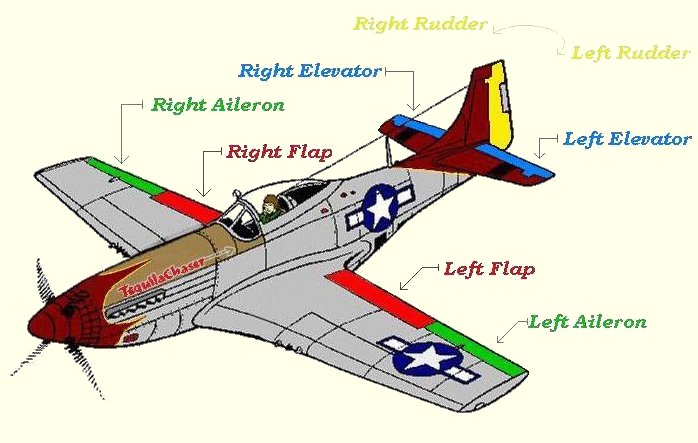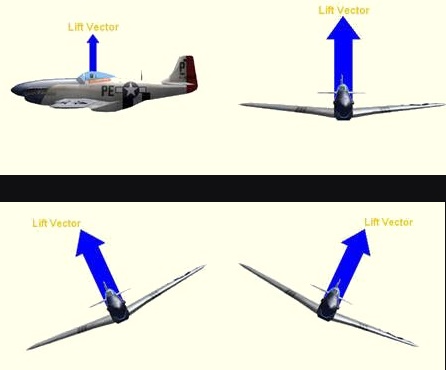by Hammer
illustrations by TC
When you move your controllers, you are moving the flight control surfaces on
your plane. There are three primary flight control surfaces – elevators,
ailerons and the rudder. The fourth set of surfaces shown on the diagram below
is the flaps.

The ELEVATORS are located on the trailing edge of the horizontal stabilizers and
control pitch. Pitch is the nose up or nose down attitude of the airplane.
Moving your joystick (or mouse) forward and backward moves the elevators.
Pulling it towards you causes the elevators to move up which pushes the tail
down, causing the nose of the aircraft to rise. Pushing the joystick away from
you causes the elevators to move down which pushes the tail up, causing the nose
of the aircraft to pitch down. Once your nose is pointed at the right angle of
climb or dive, you can release all or some of the pressure on the stick to allow
you to maintain that angle.
The AILERONS, located on the outer trailing edge of each wing, control the roll
of the plane. Roll is the side-to-side banking of the plane. Moving your
joystick to the right will cause the right aileron to move up and the left
aileron to move down. This causes your plane to roll to the right. Move the
joystick to the left and the opposite happens.

The RUDDER, located at the trailing edge of the vertical stabilizer, controls
the yaw of a plane. Yaw is the side-to-side skidding of the plane. Moving the
rudder to the left will cause the nose of the plane to move left while the tail
moves right, causing the plane to skid through the air. Rudders can be
controlled by rudder pedals, a “twisty” stick, or by the A (left rudder), D
(right rudder) and S (center rudder) key on your keyboard.

FLAPS are located on the trailing edge of the wing inboard of the ailerons.
Depending on the type of flaps, they may be located under the trailing edge or
constitute the trailing edge. When lowered, flaps add lift to the wing. This
added lift lowers your stall speed and increases low speed stability. Flaps also
increase drag on your plane which lowers your speed. Different planes can deploy
flaps at different speeds. Some planes have multiple flap positions (commonly
called “notches” of flaps) while others have only up or down. The [Q] key lowers
one notch of flaps, and the [W] key raises one notch of flaps. Flaps will
auto-retract when your speed goes beyond the speed at which they can deploy.
Some planes also have SLATS on the leading edge of the wing which, like flaps,
increases the lift of the wing. All slats in Aces High are automatic (you can’t
control them) and will pop out according to your wing's angle of attack. This often causes a
sharp jolt in your maneuver so be aware.
Now that you know what controls the movement of your plane, it’s time for a
quick note on why.
A term you will hear or read often while learning to maneuver your plane is
LIFT VECTOR. Lift is one of four forces which constantly act on your plane
while it is in flight. The lift vector is the direction of this force as applied
by your plane’s lifting surfaces – mainly the wing. In discussions where someone
tells you to “point your lift vector” a certain direction, think of the lift
vector as a line coming straight out of the top of your canopy as shown in the
illustrations below. (The reality is a bit different, but this concept of the
lift vector is adequate for discussions of maneuvering)

Note that no matter which way the plane is angled, think of the lift vector as
coming straight out of the top of the canopy.
The most efficient way to maneuver your plane is to roll so your lift vector is
pointing along the line you wish to follow and then pull on the stick. If you
wish to flat turn, roll your plane 90 degrees so your lift vector is flat to the
ground and pull. This means, at least initially, you will be flying using your
ailerons and elevators. You will use your rudder mainly while taxiing on the
ground.
As you gain experience (and maybe more advanced controllers), you will use your
rudder to assist, coordinate, and even un-coordinate maneuvers. We will save
that discussion for advanced flight concepts.
Read more about the forces acting on your plane while in flight in the
Flight Dynamics write-up. | 
